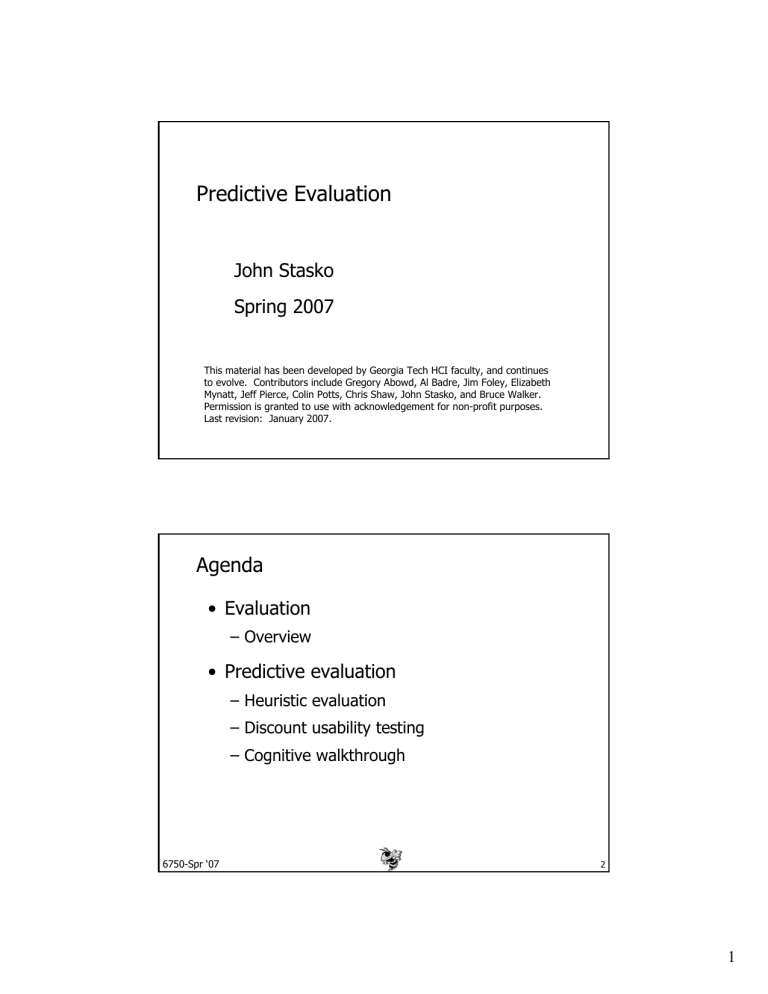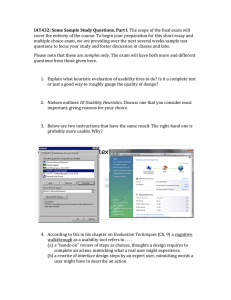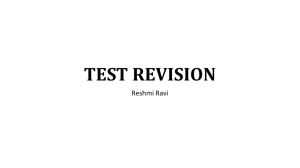Predictive Evaluation John Stasko Spring 2007
advertisement

Predictive Evaluation John Stasko Spring 2007 This material has been developed by Georgia Tech HCI faculty, and continues to evolve. Contributors include Gregory Abowd, Al Badre, Jim Foley, Elizabeth Mynatt, Jeff Pierce, Colin Potts, Chris Shaw, John Stasko, and Bruce Walker. Permission is granted to use with acknowledgement for non-profit purposes. Last revision: January 2007. Agenda • Evaluation – Overview • Predictive evaluation – Heuristic evaluation – Discount usability testing – Cognitive walkthrough 6750-Spr ‘07 2 1 Evaluation • Gathering data about usability of a design by a specified group of users for a particular activity within a specified environment 6750-Spr ‘07 3 Goals • 1. Assess extent of system’s functionality • 2. Assess effect of interface on user • 3. Identify specific problems with system 6750-Spr ‘07 4 2 Forms • Formative – As project is forming. All through the lifecycle. Early, continuous. iterative. – “Evaluating the design” • Summative – After a system has been finished. Make judgments about final item. – “Evaluating the implementation” 6750-Spr ‘07 5 Approaches • Experimental (Lab studies, quantitative) – Typically in a closed, lab setting Manipulate independent variables to see effect on dependent variables • Naturalistic (Field studies, qualitative) – Observation occurs in “real life” setting Watch process over time 6750-Spr ‘07 6 3 Tradeoffs • Experimental • Naturalistic + Replicable + More “objective” + “Ecologically valid” + Cheap, quick - Expensive, requires real users & lab - Realistic? - Not reproducible, user-specific results - Not quantitative (how much better?) 6750-Spr ‘07 7 Evaluation Methods • 1. Experimental/Observational Evaluation – Typically with users – Experiments (usability specifications) • 2. Predictive Evaluation (without users) 6750-Spr ‘07 8 4 Predictive Evaluation • Basis: – Observing users can be time-consuming and expensive – Try to predict usage rather than observing it directly – Conserve resources (quick & low cost) 6750-Spr ‘07 9 Approach • Expert reviews (often used) – HCI experts (not real users) interact with system, try to find potential problems, and give prescriptive feedback • Best if – Haven’t used earlier prototype – Familiar with domain or task – Understand user perspectives 6750-Spr ‘07 10 5 Predictive Eval. Methods • 1. Heuristic Evaluation • 2. Discount usability testing • 3. Cognitive Walkthrough 6750-Spr ‘07 11 1. Heuristic Evaluation • Developed by Jakob Nielsen (www.useit.com) • Several expert usability evaluators assess system based on simple and general heuristics (principles or rules of thumb) Essay: http://www.useit.com/papers/guerrilla_hci.html 6750-Spr ‘07 12 6 Procedure • 1. Gather inputs • 2. Evaluate system • 3. Debriefing and collection • 4. Severity rating 6750-Spr ‘07 13 Gather Inputs • Who are evaluators? – Need to learn about domain, its practices • Get the prototype to be studied – May vary from mock-ups and storyboards to a working system 6750-Spr ‘07 14 7 Evaluation Method • Reviewers evaluate system based on high-level heuristics (i.e., usability principles): • use simple and natural dialog • provide clearly marked exits • speak user’s language • provide shortcuts • minimize memory load • provide good error messages • be consistent • prevent errors • provide feedback 6750-Spr ‘07 15 Updated Heuristics • Stresses • visibility of system status • recognition rather than recall • aesthetic and minimalist design • flexibility and efficiency of use • user control and freedom • recognition, diagnosis and recovery from errors • consistency and standards • help and documentation • error prevention • match between system and real world 6750-Spr ‘07 16 8 Process • Perform two or more passes through system inspecting – Flow from screen to screen – Each screen • Evaluate against heuristics • Find “problems” – Subjective (if you think it is, it is) – Don’t dwell on whether it is or isn’t 6750-Spr ‘07 17 Debriefing • Organize all problems found by different reviewers – At this point, decide what are and aren’t problems – Group, structure – Document and record them 6750-Spr ‘07 18 9 Severity Rating • 0-4 rating scale – 4 is the most severe • Based on – frequency – impact – persistence – market impact 6750-Spr ‘07 19 Advantages • Cheap, good for small companies who can’t afford more • Getting someone practiced in method is valuable 6750-Spr ‘07 20 10 Application • Nielsen found that about 5 evaluations found 75% of the problems • Above that you get more, but at decreasing efficiency 6750-Spr ‘07 21 Somewhat Controversial • Very subjective assessment of problems – Depends of expertise of reviewers • Why are these the right heuristics? – Others have been suggested • How to determine what is a true usability problem – Some recent papers suggest that many identified “problems” really aren’t 6750-Spr ‘07 22 11 2. Discount Usability Testing • Hybrid of empirical usability testing and heuristic evaluation • Have 2 or 3 think-aloud user sessions with paper or prototype-produced mockups 6750-Spr ‘07 23 Discount Usability in Action • Mockups are not supposed to be perfect! • A variety of approaches for mockups: – Must be quick to create; economical in use of resources – Sketches most common – Paper has its limitations; tends to focus on the visual elements – Sometimes awkward to use in usability testing 6750-Spr ‘07 24 12 3. Cognitive Walkthrough • Assess learnability and usability through simulation of way users explore and become familiar with interactive system • A usability “thought experiment” • Like code walkthrough in s/w engineering • From Polson, Lewis, et al at UC Boulder 6750-Spr ‘07 25 CW Process • Construct carefully designed tasks from system spec or screen mock-up • Walk through (cognitive & operational) activities required to go from one screen to another • Review actions needed for task, attempt to predict how users would behave and what problems they’ll encounter 6750-Spr ‘07 26 13 Requirements • Description of users and their backgrounds • Description of task user is to perform • Complete list of the actions required to complete task • Prototype or description of system 6750-Spr ‘07 27 Assumptions • User has rough plan • User explores system, looking for actions to contribute to performance of action • User selects action seems best for desired goal • User interprets response and assesses whether progress has been made toward completing task 6750-Spr ‘07 28 14 Methodology • Step through action sequence – Action 1 – Response A, B, .. – Action 2 – Response A – ... • For each one, ask four questions and try to construct a believability story 6750-Spr ‘07 29 CW Questions • 1. Will users be trying to produce whatever effect action has? • 2. Will users be able to notice that correct action is available? • 3. Once found, will they know it’s the right action for desired effect? • 4. Will users understand feedback after action? 6750-Spr ‘07 30 15 Answering the Questions • 1. Will user be trying to produce effect? – Typical supporting Evidence • It is part of their original task • They have experience using the system • The system tells them to do it – No evidence? • Construct a failure scenario • Explain, back up opinion 6750-Spr ‘07 31 Next Question • 2.Will user notice action is available? – Typical supporting evidence • Experience • Visible device, such as a button • Perceivable representation of an action such as a menu item 6750-Spr ‘07 32 16 Next Question • 3.Will user know it’s the right one for the effect? – Typical supporting evidence • Experience • Interface provides a visual item (such as prompt) to connect action to result effect • All other actions look wrong 6750-Spr ‘07 33 Next Question • 4.Will user understand the feedback? – Typical supporting evidence • Experience • Recognize a connection between a system response and what user was trying to do 6750-Spr ‘07 34 17 Example • Program VCR – List actions – Ask questions 6750-Spr ‘07 35 IRB • Need to move ahead for project now • Prepare human subjects submission by next Tuesday – Sample consent forms available – Do best job with survey instruments – Must be forwarded to me – Can be amended later 6750-Spr ‘07 36 18 Administratia • Missing survey forms 6750-Spr ‘07 37 Upcoming • Requirements gathering & Understanding users – Contextual inquiry – Ethnography • Task Analysis & User requirements 6750-Spr ‘07 38 19




